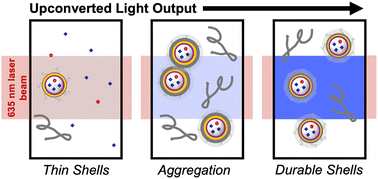Controlling the durability and optical properties of triplet–triplet annihilation upconversion nanocapsules†
Abstract
Deep penetration of high energy photons by direct irradiation is often not feasible due to absorption and scattering losses, which are generally exacerbated as photon energy increases. Precise generation of high energy photons beneath a surface can circumvent these losses and significantly transform optically controlled processes like photocatalysis or 3D printing. Using triplet–triplet annihilation upconversion (TTA-UC), a nonlinear process, we can locally convert two transmissive low energy photons into one high energy photon. We recently demonstrated the use of nanocapsules for high energy photon generation at depth, with durability within a variety of chemical environments due to the formation of a dense, protective silica shell that prevents content leakage and nanocapsule aggregation. Here, we show the importance of the feed concentrations of the tetraethylorthosilicate (TEOS) monomer and the methoxy poly(ethyleneglycol) silane (PEG-silane) ligand used to synthesize these nanocapsules using spectroscopic and microscopy characterizations. At optimal TEOS and PEG-silane concentrations, minimal nanocapsule leakage can be obtained which maximizes UC photoluminescence. We also spectroscopically study the origin of inefficient upconversion from UCNCs made using sub-optimal conditions to probe how TEOS and PEG-silane concentrations impact the equilibrium between productive shell growth and side product formation, like amorphous silica. Furthermore, this optimized fabrication protocol can be applied to encapsulate multiple TTA-UC systems and other emissive dyes to generate anti-Stokes or Stokes shifted emission, respectively. These results show that simple synthetic controls can be tuned to obtain robust, well-dispersed, bright upconverting nanoparticles for subsequent integration in optically controlled technologies.

- This article is part of the themed collection: Nanoscale 2023 Emerging Investigators


 Please wait while we load your content...
Please wait while we load your content...